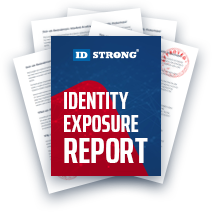CheckPeople Opt-Out
Table of Contents
What Does CheckPeople Do?
CheckPeople is a public information scavenger; they collect and compile public records into a brief snapshot of associated online details. CheckPeople's reports include a subject's full name, address, relatives, offender statuses, criminal and traffic history, social media and dating accounts, and contact information. The caveats to CheckPeople reports are their common inaccuracies, a byproduct of utilizing public information to create aggregated reports. As users move around the web and interact with checkpoints, data is picked up indiscriminately; subsequently, user error and other factors work together to create CheckPeople's report. Consumers who find CheckPeople's record inaccurate should request removal from their search results, an opt out. The guide below offers step-by-step guidance on making your request, with detailed instructions and screenshots.
How Can I Remove Myself from CheckPeople?
There are no personal requirements for opting out of CheckPeople's public searches. The opt out processes can be done for free and do not require account creation. Depending on the removal path chosen, the consumer may need access to an email or phone number for contacting purposes. Regardless of the method, we recommend utilizing alternative accounts when interacting with people search websites. Create a new email account or mask an old one before making your privacy request; alternative emails place an additional barrier between your real information and potential cybersecurity threats.
CheckPeople complies with data maintenance law as part of their cybersecurity defense. Part of this maintenance is collecting information from only the last 12 months. After this time elapses, the records are removed. The search must be run again to generate a new aggregate report based on the newest public information. For most people search sites with annual maintenance, consumers must return to request privacy changes to the new data.
CheckPeople claims once an opt out is completed, the consumer will not reappear on their website again. This needs to be revised; CheckPeople does not control public information sources within its database. They may claim the record will not reappear, but they cannot make proactive suppressions on data they don't yet know. Further, because a record is essentially dissolved after a year, there is "room" to generate new records; this is part of the reason maintenance occurs annually, it frees up database storage room.
Options to Remove Information from CheckPeople
There are multiple ways to remove a record from CheckPeople's search results. CheckPeople offers opt outs in the form of suppression or deletion. The difference between these options is the difference in returning frequency. Requesting that a report is suppressed places a flare on the record that hides it from public searches for 12 months; conversely, requesting that a report is deleted has the same impact as the yearly maintenance event described above. This new record may be more or less inaccurate than the old; and it could appear at any time as new information is made public.
Consumers should base their forward path on how often they want to manage their data privacy. Suppression requests last from when the request was made to the end of the record life cycle. A consumer would want to return annually to request a new suppression. Deletion requests dissolve a record completely, usually within 30 days of the request being made.
Consumers removing multiple reports must call to place their requests. They could alternatively email their request; however, this requires a profile URL or screenshot. Others wanting to create a paper trail can mail their request to the offices. Or, the consumer can place their request using the online form. Calling, emailing, or mailing an opt out request is treated as a request to delete the record; using the online form, on the other hand, is treated as a request of suppression.
Opting-Out of CheckPeople: The Complete Guide
Call CheckPeople's Support Helpline (Deletion)
Consumers needing to remove multiple records should call in their request. The support number, contactable at 1-(800)-267-2122, has a live queue and estimated timer. The automated message that plays allows you to "wait" or leave a callback message. Live representative hours are Monday to Friday, 8:00 am to 10:00 pm, and Sunday to Saturday, 8:00 am to 5:00 pm EST.
Start a Request Trail by Emailing the Privacy Team (Deletion)
Other users who want to avoid calling and the website should email their request to privacy@checkpeople.com. Emailed requests are treated as deletion inquiries, so future requests should be made every six months or as needed. Emails require a respective profile URL or screenshot to verify the record is live. Profile URLs refer to a records-specific website address; while a screenshot would show everything needed for a representative to complete the process on their side. Emails only need one of the two, but they are tricky to obtain.
There are two ways to collect the needed information. The first option is to use the CheckPeople Search Directory to locate the correct record; this is made difficult due to the wide expanse of names available. We suggest using the Directory over the auto search because the main search generates a record. To get to the profile, users must accept two Terms and Conditions boxes, enter an email, accept a "shocking information" warning, then pay for a subscription.
The other way to get to your profile is by searching on your favorite search engine. Google and Bing are likely the top choice. It's easy to find a live report using their searches. Into the search bar, enter your "full name + CheckPeople" to get a short list of associated results. The record profile will always have an address with a format similar to the one in the screenshot below.
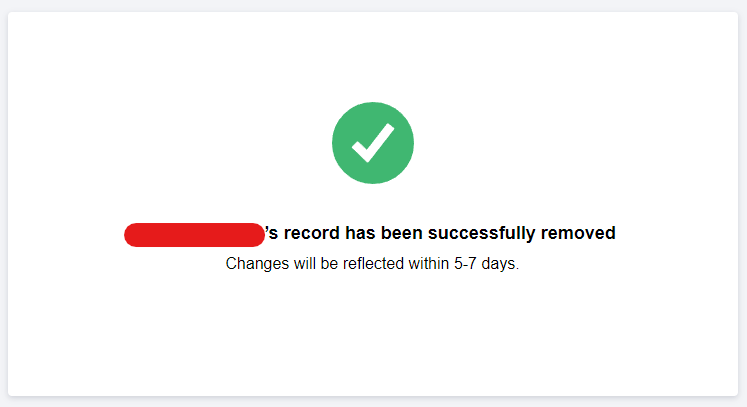
Right-click the profile URL to copy and paste it into your email; alternatively, take a screenshot of the record and attach it to the email manually. Other consumer information needed for your request email includes:
- Your full name, aliases, and alternatives
- Residential and business registered addresses
- Your date of birth and age
- Any helpful additional information
CheckPeople has up to a month of wait time before they must reply to correspondence. In some cases, they may not reply at all. This is also part of the reason we recommend six-month checks for this method.
Print Out the Request and Mail It In (Deletion)
Alternatively, consumers can physically mail their request to the company offices. Opt outs made through this avenue are considered deletion requests, so check back every six months or as needed. In the letter, include the information listed in the section above, and a respective URL or screenshot of the record. When ready to send the request, send it to Orlando:
CheckPeople LLC.
111 N. Orange Ave., Suite 800
Orlando, Florida 32801
Use the CheckPeople In-Browser Form to Make a Request (Suppression)
Those wanting a quick, long-lasting solution should place their requests online. Suppression requests last until the death of the record, up to 12 months. CheckPeople has up to a month to comply with the request; otherwise, they may reject it based on insufficiencies. Most consumers will find an automated system that enacts removals after two days. To start, open the CheckPeople "Do Not Sell or Share my [sic] Personal Information" page.
Step One
The above link opens to the first page of the online removal form. Consumers can remove records that are not theirs, but they may be required to prove agency on behalf of another. Enter a first and last name into the provided spaces, then a corresponding city and state. Then, solve the CAPTCHA puzzle, and click the bright green "Search" button.
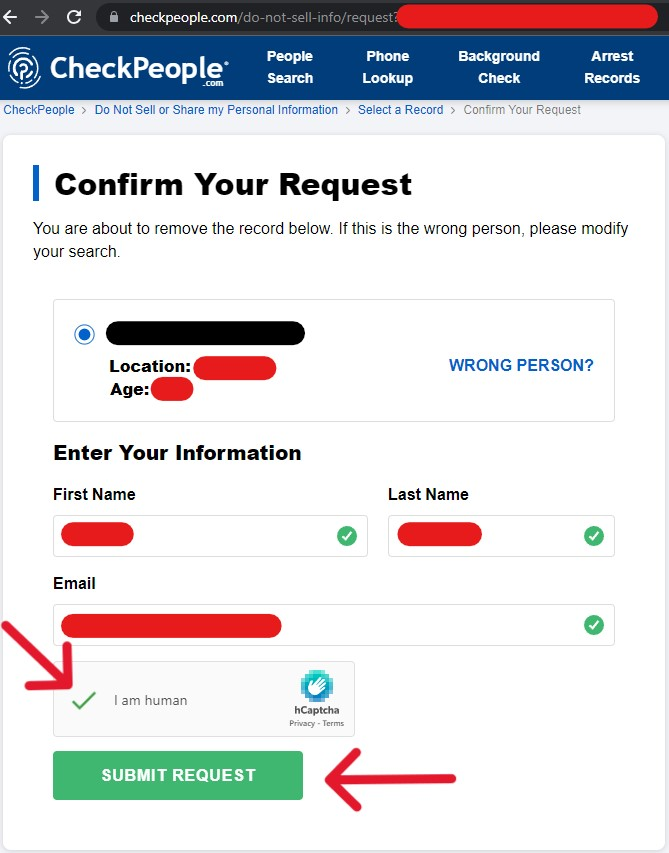
Step Two
The following page lists the results of a quick internal search. Locate the record most closely associated with your information. Click the bright green "Remove Record" button to the right when found.
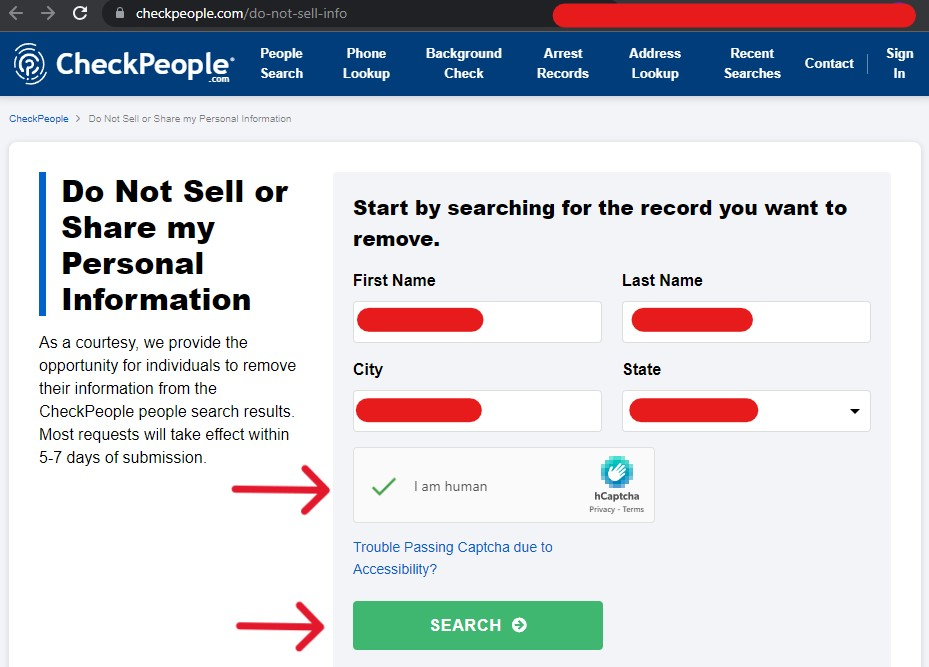
Step Three
The next page asks to "Confirm Your Request" by entering contact details. Ensure the "targeted" record is for the correct person before continuing. Fill in the first and last name spaces and the email area with a preferred alternative address. Then, solve the CAPTCHA before clicking the bright green "Submit Request" button.
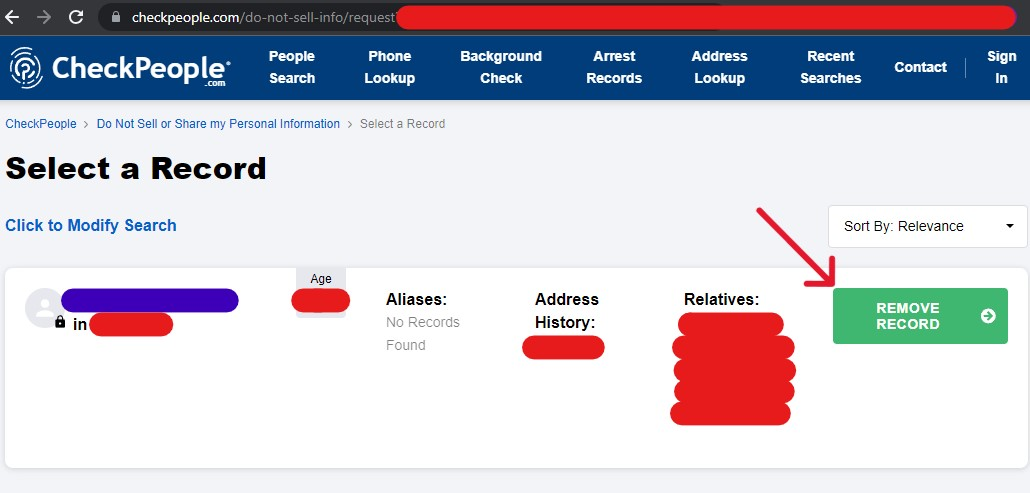
The next page will display a confirmation of removal (below) or a redirect to the entered email. These results are not based on the type of email entered (historical or new); they are a human-verification step. Those redirected to their email Inbox should locate the email sent by privacy@checkpeople.com. It will contain a limited-time link that must be clicked to complete the suppression request process.
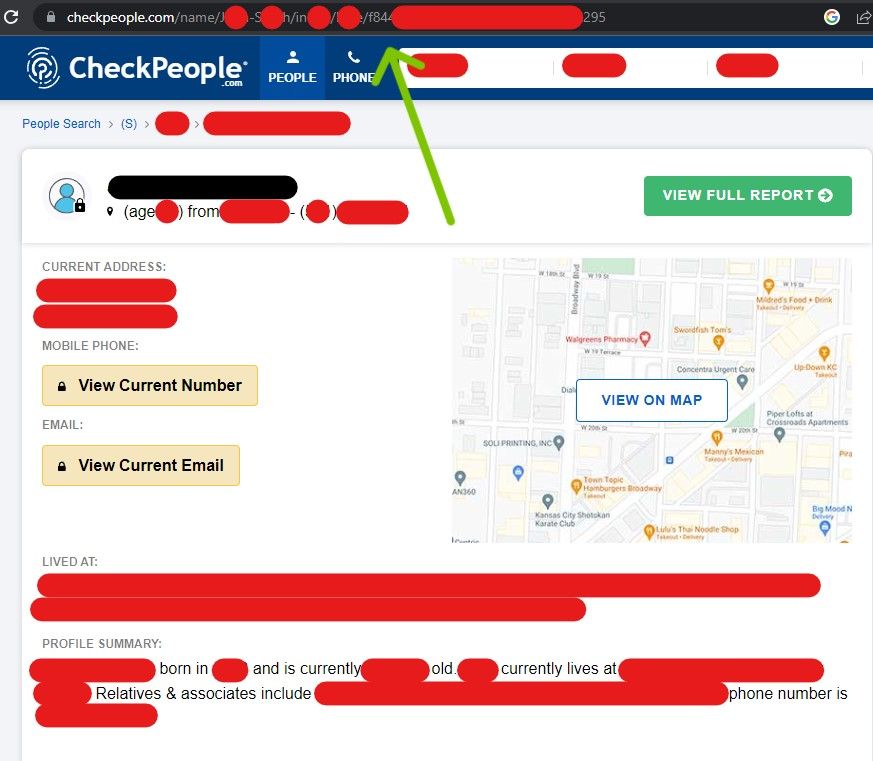
Return After Your CheckPeople Opt-Out
As mentioned above, CheckPeople claims that only one suppression request is necessary to stop a record from appearing in related searches. Erring on the side of caution is the only way to remain safe in an ever-growing age of exposure and cyber threats. Don't take CheckPeople's word for it, return annually or every six months to make informed data privacy choices. This guide is up to date with the current processes of opt out solutions provided by CheckPeople's privacy policy (2023).
